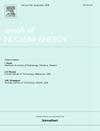Simulation of pulsatile flow and heat transfer characteristics of liquid-sodium in annular tight-lattice hexagonal rod bundles
IF 1.9
3区 工程技术
Q1 NUCLEAR SCIENCE & TECHNOLOGY
引用次数: 0
Abstract
Liquid metal-cooled reactors are important for the future of nuclear energy production. Some of the proposed reactors’ design and economic objectives necessitate a compact, flexible, and reliable core arrangement favourable to a tight lattice, annular fuel rods, and liquid sodium coolant. The thermal–hydraulic and thermo-mechanical characteristics of sodium-cooled annular fuel rods hexagonal tight lattice (P/D = 1.08) core configuration were simulated considering steady and unsteady flow conditions. The extension of the tight lattice to the edge subchannel in the 4 × 4 configuration changed the velocity, temperature, and turbulence intensity distributions compared to the 3 × 3 configuration with the conventional edge subchannel. The flow split ratio between the inner and outer subchannels in the 3 × 3 is ∼ 5.5 % compared to 11 % – 13 % in the 4 × 4 fuel assembly. The flow friction resistance-Reynolds number relationship was consistent with previous findings for square rod assemblies with water as a coolant. Deformation and thermal stresses due to the uneven temperature distribution around the fuel pin peak in the outer clad and at rod positions adjacent to the tight lattice gaps. New correlations were proposed for the transient flow friction resistance-Reynolds number relationships and the flow split ratio in an annular tight-lattice fuel assembly.
液体-钠在环形紧晶格六方棒束中的脉动流动和传热特性模拟
液态金属冷却反应堆对未来的核能生产非常重要。一些拟议反应堆的设计和经济目标需要紧凑、灵活和可靠的堆芯布置,有利于紧密晶格、环形燃料棒和液态钠冷却剂。考虑稳态和非稳态流动条件,模拟了钠冷环形燃料棒六方紧密点阵(P/D = 1.08)芯型的热水力和热力学特性。与具有常规边缘子通道的3 × 3结构相比,在4 × 4结构中将紧晶格扩展到边缘子通道改变了速度、温度和湍流强度分布。与4 × 4燃料组件的11% - 13%相比,3 × 3燃料组件内部和外部子通道之间的分流率为~ 5.5%。流动摩擦阻力-雷诺数关系与先前的研究结果一致,该结果适用于以水作为冷却剂的方杆组件。由于燃料销周围温度分布不均匀导致的变形和热应力在包壳外和紧晶格间隙附近的棒位置达到峰值。提出了环形紧点阵燃料组件瞬态流动摩擦阻力-雷诺数关系与流动分流比的新关系式。
本文章由计算机程序翻译,如有差异,请以英文原文为准。
求助全文
约1分钟内获得全文
求助全文
来源期刊

Annals of Nuclear Energy
工程技术-核科学技术
CiteScore
4.30
自引率
21.10%
发文量
632
审稿时长
7.3 months
期刊介绍:
Annals of Nuclear Energy provides an international medium for the communication of original research, ideas and developments in all areas of the field of nuclear energy science and technology. Its scope embraces nuclear fuel reserves, fuel cycles and cost, materials, processing, system and component technology (fission only), design and optimization, direct conversion of nuclear energy sources, environmental control, reactor physics, heat transfer and fluid dynamics, structural analysis, fuel management, future developments, nuclear fuel and safety, nuclear aerosol, neutron physics, computer technology (both software and hardware), risk assessment, radioactive waste disposal and reactor thermal hydraulics. Papers submitted to Annals need to demonstrate a clear link to nuclear power generation/nuclear engineering. Papers which deal with pure nuclear physics, pure health physics, imaging, or attenuation and shielding properties of concretes and various geological materials are not within the scope of the journal. Also, papers that deal with policy or economics are not within the scope of the journal.
 求助内容:
求助内容: 应助结果提醒方式:
应助结果提醒方式:


